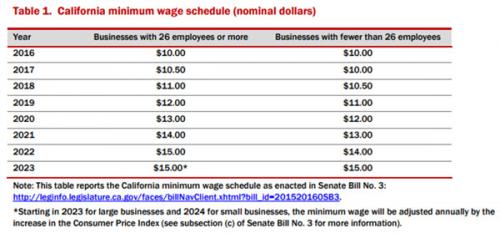
Lessons to learn from California: Minimum wage increase should be gradual
By Kaitlynn Anderson
In California, the minimum wage is scheduled to increase to $15 per hour, similar to Ontario. However, there is one major difference: the time frame for the implementation of this increase.
While the Ontario government plans to enact the change over a period of 18 months, California has set a date of 2023 – about eight years after the change began in the state in 2016.
California has already started to slowly introduce the change to help minimize shock for businesses. The state is making this change even more gradually for small businesses, which are defined as having fewer than 26 employees, according to a 2017 policy brief from the University of California, Berkeley.
California had 421,100 agricultural workers in 2016, according to the State of California Employment Development Department. And 71.2 per cent of the agriculture, forestry, fishing, hunting and mining industries will be getting a raise, according to the university report.
The following schedule was derived from the report compiled by the university’s Institute for Research on Labour and Employment:

Source: Effects of a $15 Minimum Wage in California and Fresno, Institute for Research on Labour and Employment, University of California, Berkeley
Once the minimum wage has risen to $15 per hour in California, subsequent adjustments will be made based on the Consumer Price Index (CPI). To further ease the transition for small businesses, they will not have to adjust to increases based on the CPI until 2024. (Large businesses, in contrast, will begin these adjustments in 2023.)
University of California researchers found that small minimum wage increases of up to 25 per cent result in relatively small income, scale and substitution effects. However, as minimum wage increases, the positive income effect weakens.

Photo Credit: iStock/Getty Images Plus/papan saenkutrueang photo
The proposed change to minimum wage in Ontario would be an increase of 32 per cent.
In 2016, 12,305 Ontario farms reported hiring labour, according to data collected in the 2016 Census. BF



Post new comment